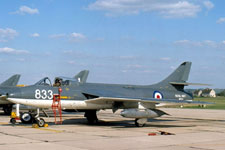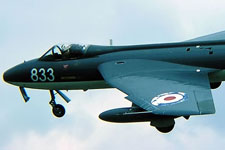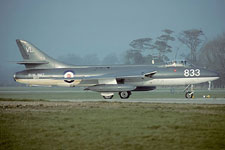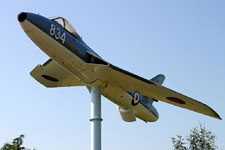| WW654's service history
WW654 was built by Hawker Aircraft (Blackpool) Ltd as a Hunter Mk.4 for the Royal Air Force. It was received by the RAF at 5MU (Maintenance Unit) at Kemble, where it was prepared for service. Its first squadron posting was to RAF Jever in West Germany, where it was flown as part of RAF 98(F) Sqn's fleet of Hunters. It remained tasked in mainland Europe until November 1957, when it returned to the UK to join 229OCU (Operational Conversion Unit) at RAF Chivenor in Devon. WW654 was then employed on training duties until it was withdrawn and placed in store in 1961.
WW654 was one of 40 Hunter F.4s transferred to the Royal Navy, and Hawker Aircraft Ltd was contracted to overhaul and convert the aeroplanes to GA.11 standard.
Following the completion of this work, that took place at Kingston-upon-Thames and the subsequent flight testing phase from Dunsfold, WW654 was delivered to the Fleet Air Arm at RNAS Lossiemouth in September 1962. It was assigned to 738 NAS (Navy Air Squadron) later that month, and was operated as aeroplane '650' with a 'LM' shore code applied on its tail fin until a move to Shorts Brothers at Belfast occurred in June 1963. WW654 was then used by Shorts for the next two years until a move to 5MU Kemble took place on 1st July 1965, where it underwent modernisation and was placed in long-term store. It remained 'mothballed' at Kemble until November 1974, when it was returned to Shorts for further modernisation work in preparation for a return to Fleet Air Arm service.
WW654 joined the Fleet Requirements and Air Direction Training Unit (FRADU) at RNAS Yeovilton on 30th June 1975, where it was assigned the call-sign and fleet number '833' and the shore code 'VL'. For the next five years, WW654 was used extensively as the lead aeroplane for the FRADU's display team Blue Herons, flown by the team leader Derek Morter, and also spent time at 5MU Kemble receiving maintenance (February 1977) and paint refinishes (May 1979 and May 1980). In May 1981, WW654 was again moved at Kemble in order to receive modernisation work, returning to the Unit in April 1982, where it flew with FRADU consistently for the next two years.
On 6th April 1984, the aeroplane was ferried to RAF St Athan, where it was re-finished in the new standard dark sea grey colours chosen for the FRADU fleet.
It returned to Yeovilton on 2nd May 1984, and was immediately re-introduced into the fleet.
On February 11th 1987, the wings and front fuselage of WW654 were delivered by road to RNAS Culdrose along with the rear fuselage of GA.11 XF368.
A composite airframe was assembled two months later, and following the assignment of the Fleet Air Arm maintenance serial 'A2754' it was refinished into extra dark sea grey and white colours and given the new fleet number '834' and shore code 'DD' (Dummy Deck), in readiness for its new role with the School of Aircraft Handling (SAH).
In March 1993, WW654 was withdrawn from use and moved to 820NAS' hangar at Culdrose for storage and future disposal. |

[© Robin A. Walker]

[© Arie van Groen]

[© Mick Freer]
|
WW654's civilian life
WW654 was acquired by Harry Pounds via tender, and it was moved to Portsmouth by road on 15th December 1993. It was placed in store for the next five years until it was sold into new ownership in 1998 to Peter Hague. Following a period of restoration at Tangmere in West Sussex, WW654 was mounted on a pole and positioned close to the entrance of the former Royal Navy Air Station at Ford, in tribute to its previous life as an active airfield.
It underwent a complete refinish during the summer of 2003 and remains on guard today, sporting its RNAS Culdrose composite colours.
- December 2020 |

[© author]
|




